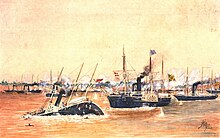The Montevideo Naval Division or Rio da Prata Naval Division was a Brazilian naval division based at the Port of Montevideo and operating in Uruguay from 1851 to 1878.
| Montevideo Naval Division | |
|---|---|
| Divisão Naval de Montevidéo | |
 The Brazilian frigate Amazonas rams and sinks the Paraguayan Jejuy. | |
| Active | 1851–1876 |
| Country | Empire of Brazil |
| Branch | |
| Type | Naval Division |
| Garrison/HQ | Montevideo |
| Engagements | Uruguayan War Paraguayan War |
| Commanders | |
| Notable commanders | Marquis of Tamandaré John Pascoe Grenfell Baron of Amazonas |
It was created in compliance with article 4, of the Treaty of Alliance between Brazil and the Oriental Republic of Uruguay, which aimed to militarily assist in political stability after the Uruguayan Civil War.[1][2]
The text of the treaty declared that the objective was to protect Uruguayan independence, pacify its territory, and expel Oribe's forces.[3] Urquiza would command the Argentine forces and Eugenio Garzón would lead the Colorado Uruguayans, with both receiving financial and military aid from the Empire of Brazil.[4]
The government of Montevideo rewarded Brazil's financial and military support at the final stages of the war by signing five treaties in 1851 that provided for perpetual alliance between the two countries.[5]
Origins
editWith independence of Paraguay and Uruguay was secured, and the planned Argentine invasion of Rio Grande do Sul was blocked.[6] In a period of three years, the Empire of Brazil had destroyed any possibility of reconstituting a state encompassing the territories of the old Viceroyalty of the Río de la Plata, a goal cherished by many in Argentina since independence.[7]
Brazil's army and fleet had accomplished what the United Kingdom and France, the great powers of that time, had not achieved through interventions by their powerful navies.[8] This represented a watershed for the history of the region, ushering in Brazilian hegemony over the Platine region.
Once the political situation and territorial threats in the La Plata Basin stabilized in the 1870s, Uruguay ceased to be a matter of political concern for Brazil.[9] On the other hand, the region also lost economic importance, as the internal agricultural frontier expanded and also Brazil's domestic industry, greatly benefited during the war years.[10] The Naval Division was disbanded in 1876.
Ships
editIn 1869, the Divisão Naval de Montevidéo was composed of:[11]
| Frigate | |
|---|---|
| Amazonas (Flagship) | |
| Corvettes | |
| Vital de Oliveira[12] Beberibe[13] | |
| Patache | |
| Iguassú[14] | |
See also
editReferences
editCitations
edit- ^ Simões Cosso 2004, p. 55.
- ^ Teixeira Soares 2021, p. 83.
- ^ Vianna 1994, p. 527.
- ^ Maia 1975, p. 256.
- ^ Teixeira Soares 2021, pp. 203–215.
- ^ Golin 2004, pp. 42, 43.
- ^ Lyra 1977, Vol 1, p. 164.
- ^ Calmon 2002, p. 195.
- ^ Doratio 2014, p. 59.
- ^ Doratio 2014, p. 60.
- ^ "Almanak da Marinha" (PDF). Município Neutro. 1870. Archived (PDF) from the original on 20 May 2022. Retrieved 4 January 2022.
- ^ "Corvette Vital de Oliveira". www.naval.com.br. Retrieved 4 January 2023.
- ^ "Corvette Beberibe". www.naval.com.br. Retrieved 4 January 2023.
- ^ "Patache Iguassú" (PDF). www.marinha.mil.br. Retrieved 4 January 2023.
Bibliography
edit- Teixeira Soares, Álvaro (2004). Diplomacia do Impériono Rio da Prata (até 1865) [Diplomacy of the Empire in the Rio de la Plata (until 1865)]. Brasília. ISBN 978-65-87083-17-9.
{{cite book}}: CS1 maint: location missing publisher (link) - Vianna, Hélio (1994). História do Brasil: período colonial, monarquia e república (in Portuguese) (15th ed.). São Paulo: Melhoramentos.
- Maia, João do Prado (1975). A Marinha de Guerra do Brasil na Colônia e no Império (in Portuguese) (2nd ed.). Rio de Janeiro: Livraria Editora Cátedra.
- Simões Cosso, Marcos (2004). "Convivência entre contrários: causas e conseqüências do fim do governo de Giró". Política Exterior do Brasil para com o Uruguai no periodo de 1852 a 1864 [Brazilian Foreign Policy towards Uruguay from 1852 to 1864]. Santa Maria: Federal University of Santa Maria.
- Golin, Tau (2004). A Fronteira (in Portuguese). Vol. 2. Porto Alegre: L&PM Editores. ISBN 978-85-254-1438-0.
- Lyra, Heitor (1977). História de Dom Pedro II (1825–1891): Ascenção (1825–1870) (in Portuguese). Vol. 1. Belo Horizonte: Itatiaia.
- Calmon, Pedro (2002). História da Civilização Brasileira (in Brazilian Portuguese). Brasília: Senado Federal.
- Doratio, Francisco (2014). O Brasil no Rio da Prata (1822–1994) (in Brazilian Portuguese). Vol. 2. Brasília: Fundação Alexandre Gusmão.